From Italy to Eastern Europe, via the Balkans and the Middle East. A year-long backpacking trip.
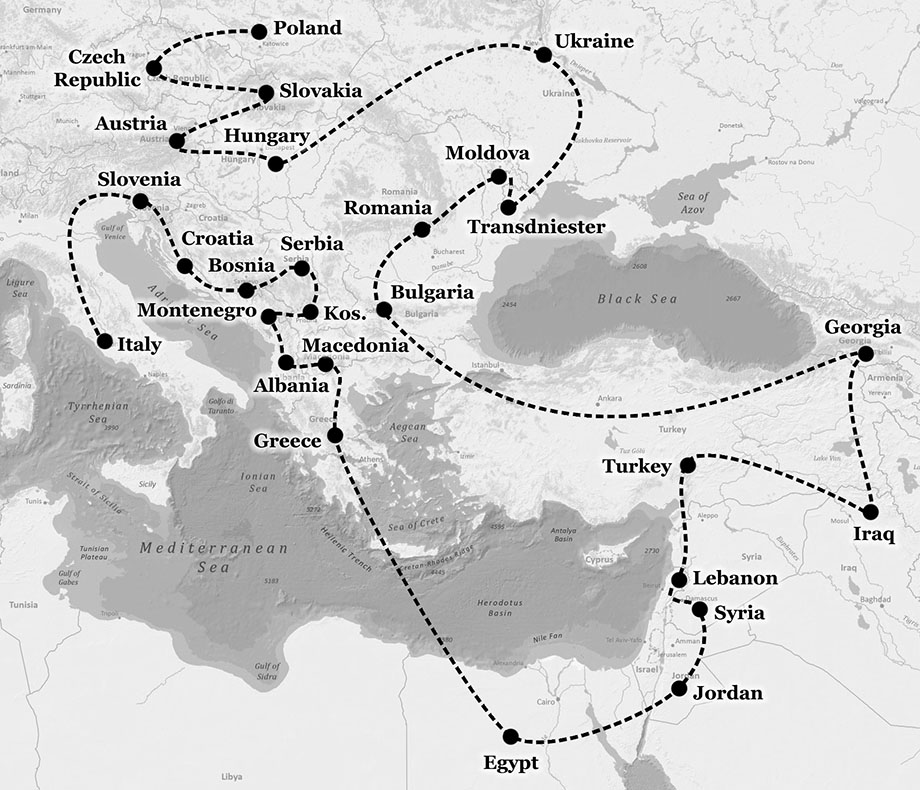
This humble corner will attempt to serve as a travel journal of sorts, cataloging all the ins and outs as, whatever way and in whichever direction the mind meanders, the body does likewise. If you have arrived here, you likely know me, and at least some of the details of this trip. Regardless, welcome, fellow traveler.
Slovenia
on Nov. 28 2008
Never having quite figured out how to get from Italy to Piran, Slovenia via train I make it only as far as Trieste (Trst in my new language) before wandering about in search of a bus station and a ride into Slovenia. The border is a bit disappointing, the bus doesn't even stop. This whole EU thing is quite tragic. Piran was a quiet little town, beach party central in the summer but drizzly and gray at the moment. Why is it that tourists are all into taking pictures of graffiti (someone recently asked me)?

My "hostel" is more like a hotel, and exploring the town I encounter maybe two other people my own age. No need to stick around, the next day I hop on a bus up to Ljubljana (j is y in Slovene, naturally), das kapital. I remember why sitting in the back seat on long car rides was never my forte. A bit snowy, cold, Christmas preparations frantically underway. Any overcast city yields only abysmal pictures during the day, and so Ljub at night:


Two days is more than enough for Ljub, unless I am going to get desperate and go to the zoo or some such. I do wander into the National Gallery and wander through some exhibits before being kicked out for not having a ticket. Nights are awesome, the whole city seems to be walking around and drinking at outdoor cafes clustered around the Three Bridges and the main square, huddled around heat lamps. It hits zero degrees just about at sunset, much too warm - on to Bled, up in the mountains.



The city of Bled is definitely a quiet little place in winter - an unfortunate theme for this time of year pretty much anywhere in Eastern Europe. Partake in an excursion to the local Irish Pub with John (from Ireland), which is lively with a half dozen or so people. The Guinness is just not the same, I'm told. Hike around the lake, have to see the postcard view of Bled Island.


Wander up some mountain in search of a good "vantage point", the girl at the hostel told me. The trail I hope to follow is actually just a ski slope. Bitter cold walking about in a foot of snow, complete with little hidden mini-rivers, especially when the boots are apparently not really waterproof. Still have all my toes though. The next day make it to a place called Vintgar Gorge, a bunch of wooden bridges and walkways suspended over a gorgeous turquoise blue river running down some gorge. Definitely closed, a stick figure man with a giant red X and an ominous sign in Slovene makes that clear. But, (a) it was recommended by a local, and (b) footsteps lead off into the distance, ample encouragement. A bit sketchy, some missing boards here and there, broken handrails, and avalanches of snow covering the walkways. Not meant for winter, but all the better for it.


Back to Ljubljana for a night in order to make it down to see the Postojna Caves, which were described as a bit Disneyland (the tour starts with a train ride into the mountain), but worth it. And besides, I didn't wake up in time to make it to Skocjan, the less touristy cave destination in Slovenia.
Goodbye to Ljubljana and Slovenia, the city is transformed the second time I am there. The snow has all melted and Christmas lights, with some strange astro theme, cover buildings and hang suspended over squares. Castle Ljubljana on the hilltop has some crazy lighting setup that lets it fade between any color, which it does quite happily. I approve.
Croatia
on Dec. 4, 2008
The train happily transports me from Ljubljana to Zagreb. Definitely no love lost at the border, as the customs guys look through my backpack searching for who knows what. Once across everyone lights up cigarettes and the train fills with smoke, welcome to Croatia. Zagreb is drizzly and wet, but everyone is bustling about.


At the hostel (Fulir Backpackers, the first on my "amazing" list) I run into the same John from Ireland from Bled, Slovenia. Small world. We team up with Eric, an ex-coast guard from the states, and wander over to some bar called Portal, where the locals take a liking to us. We hang around at closing time and they take us to a club in the park behind the cathedral (about as sketchy as it sounds). Eric fell in love with a Croatian girl and swears he will return to Zagreb and abandon the rest of the trip, I'll believe it when I see it. The next night is equally bad for my sleep (we trade the coast guard for two Americans studying abroad in Budapest, one who grew up in Mendocino, and the bar for a jazz club), and after two nights of getting home at 5am it is time to get out of here.




A few hours on a bus lands me in Split, back on the Adriatic Coast. A charming little place, though I am a bit disappointed that the pictures of the main attraction (Diocletian's Palace) that I had seen were actually artistic interpretations of what it used to look like. A bit less picturesque now. And some good Eastern European angst from times past.

Though, to be fair, Old Town Split is gorgeous, the perfect place for a rest.


I'd heard that Dubrovnik puts Split to shame, so the appropriate order when visiting both is clearly the good one first, and awesome one second. Dubrovnik ("Pearl of the Adriatic", Lord Byron) didn't disappoint.

Accompanied by Chris (the Bermudan oceanographer) we crash a local bar and meet among others a guy from Sacramento living in St. Petersburg who convinces me it is a must. So many places and so little time.
Bosnia and Herzegovina (BiH)
on Dec. 10, 2008

So begins the part of this trip which I suspect is not on the normal vacation itinerary. The Dubrovnik bus station provides me a ride into Bosnia (B&H, officially), to the town of Mostar. What does Mostar have to offer? I'm not quite sure, the few people I've asked have said it has a bridge! so I'm banking on that. Mostar, though, is one messed up city.


Buildings are riddled with bullet holes, and small impact craters from mortars still mark the streets. Across the river from the hotels and cobblestone street (singular) is a giant park, with the shattered husk of a 20-something story office building in the background, all the windows shattered, abandoned. The bridge, though is quite nice. The next morning the most unnerving train ride yet lands me in Sarajevo, the capital.

Things aren't quite as colorful, though I suspect five years ago it looked much like Mostar. The National Library still stands proudly destroyed, covered indefinitely in scaffolding (ran out of money). Night one I find myself sharing a dorm room with a German physicist and a mathematician from Taiwan - you can imagine how interesting our conversations were. After climbing to the top of the nearby hill (worrying about my general lack of knowledge about land-mines the entire time) I find myself in the company of a chemist from New Zealand and an English philosopher at some random club called Cinemas; a rather late night.


Sarajevo is an amazing city though. It may sprawl from horizon to horizon with the ugliest apartment high-rises, but the old area is covered in bazaars, churches, and mosques. The first time I have heard (except maybe for Malaysia?) the minarets of mosques blaring their calls to prayer. Especially welcome pre-sunset. The most striking thing about Sarajevo, perhaps, the number of cemeteries, not the sign of the most peaceful past.


Serbia and Kosovo
on Dec. 13, 2008
My enjoyment of 8+ hour bus rides begin with the trip from Sarajevo to Belgrade, Serbia. I arrive at some place called Manga, where it seems everyone is headed, and who am I to be different. Despite the drizzling rain, Belgrade is an alive city, the first time since leaving Rome that I've found actual traffic. I suppose that goes hand in hand with millions of people stuck in the same place. The fortress of Belgrade, Kalemegdan, is a sprawling affair, best visited at sunset for views of the Danube (my first) and a folk dancing circle that is more than happy to have some travelers step in. Not to mention a military museum with equipment from captured U.S. pilots during the 1999 conflict.



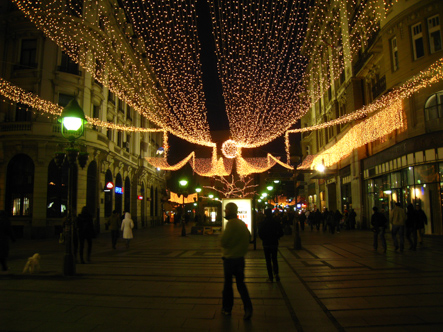
Belgrade is, or so I've heard, the city that never sleeps (especially on Monday nights). At some point I find myself headed towards "live music" with Wiley Ily (as we call him), a Bulgarian guy in town to see a death metal band from Florida perform (…), and a guy from South Africa whose name I swear is Cole, though the Serbian girls we meet that night later insist his name is Pablo (a bit strange for a South African I thought). In the end, it was Paul, though I can't decide who was closer. Our live music was more an hour of American covers followed by an hour-long house set, rinse and repeat. We made the acquaintance of the three aforementioned Serbian girls, and at the end of the night jump in their car for a half-block drive to the local 24-hour bakery (godsend). A bit of a strange night, though I decide I like Belgrade.
At Manga I also find myself in the company of Tam, the English philosopher, once again, and we take a trip up North to Novi Sad, home of the EXIT festival which I will definitely have to return for. One of the highlights (for science folk like myself) is the Nikola Tesla museum, which includes his remote controlled boat, that no one believed wasn't connected with wires, and his designs for wireless power, the Tesla pump, and other such goodness. Along with his cremated remains, in a copper sphere.

And for those that have never experienced a Serbia-Kosovo border crossing (somewhere around 3am, no less) it is a highly recommended experience. I arrived to a little town called Prizren, as no transport from Serbia "goes" to the capital, Pristina, despite the fact that nearly every bus stops there en route to other destinations. Prizren is definitely one of the sketchiest places I have been yet. KFOR (NATO Kosovo Force) troops buzz down the streets, signs proclaim the authorized use of firearms in off limit [Serbian] neighborhoods destroyed during riots. And, I am fairly certain I see a bomb go off across the street from me. At least, there was a ridiculously loud boom, followed by flying boards and pipes, a cloud of black smoke and the fairly messed up side of an apartment building. The guy immediately upstairs peering out curiously from his window, though no one else seemed overly concerned. I didn't stick around.
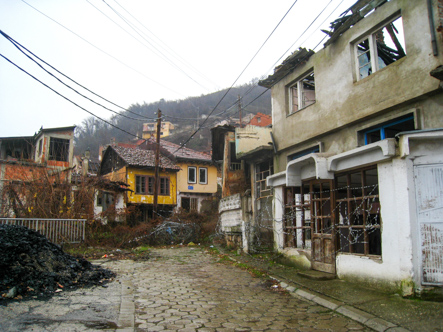
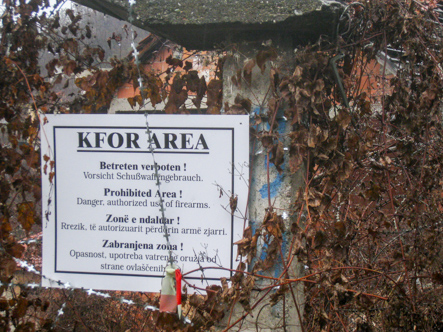
Getting out of Kosovo involved an [unexpected] eight hour stop in Pristina, the capital, where I sipped on an espresso while watching white UN trucks file in and out of the UNMIK headquarters, complete with those cool mirror-on-a-stick-bomb-checking-devices from the movies (I decide against photographing the security checkpoint of UN headquarters).
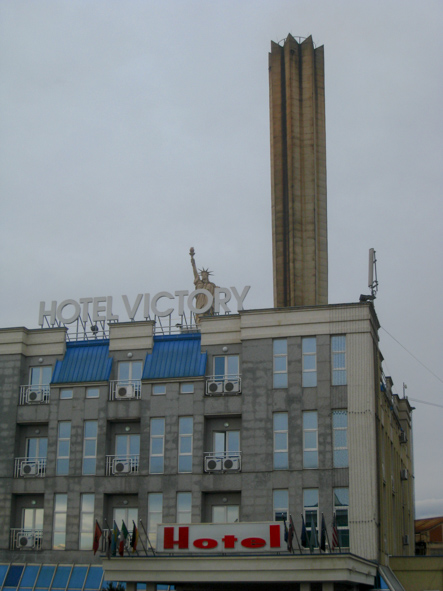
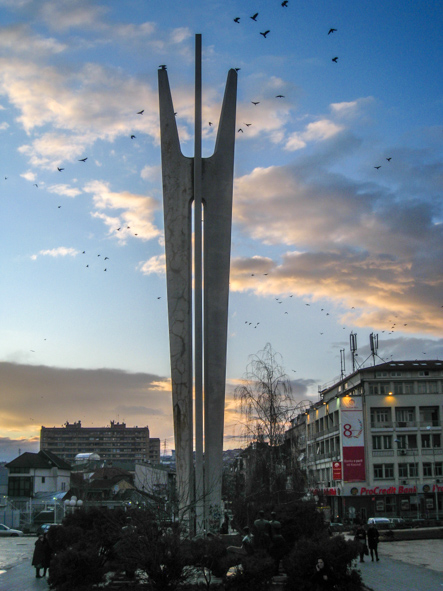

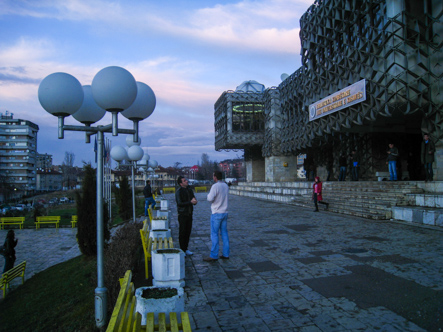
Kosovo definitely has its character, though I'm not quite sure it is ready for mass tourism yet.
Montenegro
on Dec. 19, 2008
So, I discover that Pristina and Podgorica, the capital of Montenegro, are a bit further apart than anticipated. At least, my bus ride turns into a 6pm-6am adventure, sometime in the middle of which I wake up, sliding out of my seat as the bus careened around a mountain pass and slid to a stop at a border control post in the inky blackness of night. Through Podgorica, and by the time the sun rises I have made it all the way to Budva on the coast.


When I arrive to the hostel the door is opened by an old, grey-bearded man who beckons me in, sits me down in the living room and pours me a shot of rakija. The living room being his living room, the hostel being his house, which for the next two nights I share with Rotog, his wife, and his thirteen year old water polo champion son (we go to his match that night; Budva vs Kotor. Final score: 15-0). Obviously, in the middle of a stint of renovations, I an fairly certain they weren’t expecting anyone in mid-December. Still, I am part of the family in no time.



Centinje, Kotor, and the coast of Montenegro. Kotor isn’t against the sea, but rather a gorgeous bay/fjord-scape, but dissolves into a massive mountain to the land-side which is dotted with fortresses, lookout towers, and walls in various stages of ruination. Wanderings are cut short by the decision to scale up to a speck of a flag waving high above. The bay shields the town which is already in shadows, while the hilltops still glow with a golden hue, definitely the place to be.


Albania
on Dec. 21, 2008
Having failed to find any information whatsoever on how to get from Montenegro from Albania, I head to the bus station. The bus takes me from Budva to Bar, where helpful taxi drivers assure me there is no way to get to Albania (except via taxi). Bar to Ulcinj, closest to the border, where I discover the next bus is at 6am the follow morning. A helpful taxi driver is suddenly standing beside me, smiling. Thirty-five euro to Skodra, fuck. We negotiate by scrawling numbers in the dusty windowsill of the ticket office. Another option arises, just to the border, twenty euro, which I can cross on foot and then catch a cheap minibus into town, I am assured. So commences a terrifying half hour ride through the rolling green hills of southern Montenegro, speeding along a one lane road as fast as possible in a Mercedes, passing locals who are chugging along at a sluggish 100 km/h. He doesn’t wear a seatbelt, so I can’t very well, can I? Besides, I’m not sure the “taxi” has any. My driver makes some hitchhiking motions and mentions the border – I have a feeling the minibus may only be a fable.

There is no bus. I am saved by an Italian/Albanian couple, who give me a ride through the gypsy quarter as kids mob the car. An impressive first ever hitchhiking experience. They drop me all the way at Skenderbej Square in Tirana - welcome to Albania.


The next day, I set out to conquer a mountain. For some reason I am reminded of The Man Who Went Up a Hill and Came Down a Mountain. The destination is Dajti, 23km east of the center of Tirana. Turns out the entire top is some sort of military zone, and at some point I am intercepted in my hike by three guys in uniforms and large guns which make it clear I should turn around. A few hours along the path in the other direction and I am eventually foiled by a guard dog watching over a herd of sheep, and eventually a shepherd. With no English, my walking motions and gestures forward receive an undecipherable response and a shake of the head, side to side. Which in Albania (just to complicate things) traditionally means yes, whereas up and down means no, except that nowadays Albanians helpfully reverse back to the Western tradition for tourists, making it totally impossible to differentiate between an affirmative or negative in any given situation. Time to get off the mountain, before sunset, some beautiful views.


Bus stations, and bus schedules, are a thing of the past: the next morning I head to an X marked at a random spot on my map of Tirana. Rather, one shows up at the appropriate street corner somewhere on the outskirts of the city, depending on destination (although these corners move about with time). In my case I arrive and flounder about until I discover a group of guys standing together, smoking, occasionally shouting out the names of towns at passerbys, confused looking backpackers, or the general throng. I connect with one who points to his 9-person minibus/van parked down a side street, empty: departure occurs when the bus has been filled to capacity with paying customers. I have a while to wait. (I won't master this informal minibus system with casual confidence until the Middle East).


To Kruja, a small town butting up against eastward stretching mountains. The old bazaar, a single cobblestone street, anchored at one end by a mosque and at the other by the entrance to a fortress. In the waning sun in the middle of winter it seems more a part of the town than anything else, street vendors chatting amongst themselves, kids running around chasing turkeys, and an old lady lighting a fire in some underground pit. My last Albanian sunset.


F.Y.R.O.M. (Macedonia)
on Dec. 24, 2008
Now, why exactly was I in Macedonia? Other than it being the last place decidedly in the way between Greece and I, there isn’t really a good reason. A man at a desk in Tirana happily sells me a bus ticket to Tetovo when I ask for Skopje, and it is well into a bitter cold, snowing night by the time I finally arrive to Skopje, Macedonia -- Christmas Eve.

A day adventure out to Lake Ohrid. Early afternoon is a brisk -1 deg C, a light snow falling. St. Johan Kaneo is perched on a steep peninsula overlooking the lake, while inland I wander through excavations of some large archaeological site, including the covered remains of an “early Christian basilica” which is more impressive than many I have seen in Italy, and the reconstructed medieval Plaosnik. Lording over the Old City is Samuel’s Fortress. As a blizzard starts, I head back into down, warm up with a cappuccino, then join the locals, sliding more than walking down sidewalks to catch a bus back to Skopje. The vigorous wind scatters piles of snow into landscapes that remind me of sand storms. I can see absolutely nothing, and fall asleep, content to rely on the driver’s sixth sense. I am amazed when we stop in the pitch blackness, the road stretching out in both directions, only sheets of snow visible in the beams of the headlights, to let someone off, who promptly disappears into the night.

Christmas, 2008. I find myself lost in a snowstorm, wandering the streets of the capital of Macedonia.
On the plus side, it is my first white Christmas.

Hostel-Hostel is quiet, I am in fact the only guest. Oh, the Balkans in winter. The cute girl working there is watching TV, half sleeping on the couch - doesn’t seem like a terrible job. The place is cozy, filled with the smell of wood smoke, and a free “traditional Macedonian dish” each night turns into my delicious dinner. A lovely refuge to buttress my otherwise chilly explorations of Skopje by day. Only warmer from here on out, for the rest of the trip, I tell myself, a train ticket for 07:00 the following morning in hand, promising to carry me out of this country and finally to the place I have been making my way towards for the past six weeks – Greece.
Greece :: Part I
on Dec. 27, 2008
The train takes me happily from Skopje to Thessaloniki, Greece. The only takeaway message I got at the border was that "free camping is strictly prohibited". Very well. Thessaloniki only lasts a day, for me at least, before I am headed back to the train station and down to Athens. My super-slow, super-cheap train turns out to be the EuroStar Plus first-class, crazy-expensive train, with no alternatives (according to the most unhelpful lady at the ticket counter). On the plus side, I got lots of free peanuts, drinks, newspapers, just like a plane. And also the offer for a free apartment in Athens for a month, though it came from a mid-30s gay Romanian man, and I don't think it would have ended all that well.
There is something about Athens I like. Yes it is just a huge sprawling city, extending to the horizon in every direction with the same 3-4 story dirty white buildings, but once you come down off the hill and wander around the streets there is just so much to do. The Arch. Museum is one of the best I have ever seen, and gets put with the Vatican as my favorite. Inside, the gold funerary mask of Agamemnon. A name which, even if you don't know it, must belong to someone powerful and long gone.


The dozens of other pictures can wait. I hold off a few days before joining the mobs of tourists on the Acropolis, the must-do for Athens. All in all, impressive, though the Parthenon covered in scaffolding really makes pictures difficult. As does the permanently overcast world in which I find myself.

On the slopes of the Acropolis, the Theatre of Dionysus, where the plays of Sophocles, Euripides, Aristophanes, and Aeschylus were all first performed. It's like Ancient Greece class all over again, though I don't remember much more than the titles of all the plays I had to read.

There is definitely the less polished side of Athens as well. It feels good to get off the "tourist track", highly recommended as a thick red line on the various free maps that one accumulates. Athens feels like a city where it would be impossible to see everything, even given a lifetime. But it is also like Rome, so ridiculously full of history and the monuments of history that you have to stop every once in awhile and just wonder at how things must have once been. Still, graffiti makes a cool picture.


After a quiet Christmas I am in Athens for New Years, which is anything but. The hostel has a rooftop bar where the intoxicated revelers drink champagne, watching fireworks over the Acropolis as the clock hits midnight. Perfectly cliche.

The adventures in search of clubs in the aftermath turn out to be a bit absurd. Athens is swarming with wild dogs, who for the most part have been rounded up and given shots and collars. (The popular story, in all the tourist leaflets, tells of how all the strays were rounded up just before the Olympics, in order to clean up the city, and then released just afterwards, because they are just such a symbol of Athens. A local assures me this is bullshit, and that all the dogs they did catch were killed. Oh the spin). One, who we name Rex, sleeps just outside the hostel on the warmth of the door mat. On this night he trots after the group as we head out, and after getting utterly lost in search of a club, faithfully guides us back to the hostel.
On the first, the day of recovery, myself and an Alaskan (if you ever hear "Welcome to Alaska" while traveling abroad, run) head down to the sea on the one sunny day of my stay in Athens. The highlight must be the old Greek man in his Speedo repeatedly pummeling an octopus against the rocks on the beach. I have video. Also, the most ridiculous collection of huge yachts that I have ever seen.


It reminds me of one of my goals on this trip, to meet a beautiful woman with a giant yacht and go sailing for a month, or two, or three. One of the less realistic goals, I'm afraid. That night includes a trip to Psirri, a neighborhood I had walked through earlier and watched guys cutting heroin (or some brown substance, complete with a mirror and razors) on a doorstep, while others offered who knows what with whispers of "my friend, my friend," where the Alaskan and I are joined by two girls from Holland and a guy from El Salvador which I must admit we had, up until that point, called Johnny Depp. But I did learn his real name so now I feel a bit bad calling him so. We end up at a place with a drink menu only in Greek (which I can read, but not understand), and the only thing that rings a bell is raki. So we end up with two pitchers of raki (more or less, just 50% alcohol), and quickly make friends with the nearby tables to steal their hookah in exchange for free shots. By 4am we stop in at the local crepe-making place (with some fancy name I can't spell) as part of the adventure to find our way home - a good night.

After another day or two exploring Athens the guilt starts to settle in - the guilt of being in one place for too long. In some sense, the trip has only just begun, and the world is a big place. I promise myself that the next day I will finally check out of the hostel (until this point, I have been showing my face at reception, each morning, only just in time to ask if I can stay… just one more night) and catch a bus - somewhere.
Greece :: Part II
on Jan. 4, 2009
I cruise over the Corinth Canal in the bus but otherwise skip the city, as ships slide through the narrow strip of water, far below, with what seems only a few inches of clearance on either side. I head instead for Nafplio, recommended to me by the Scottish hostel owner in Athens. Nafplio's claim to fame is its trio of fortresses: Bourtzi, on a small island in the harbor, Akronafplia, a sprawling affair partly taken over by modern (and abandoned) hotels, and Palamidhi, the main attraction, perched atop a rugged peak and accessed with some 1000 steps.

Ancient Mycenae, the citadel of King Agamemnon, is nearby, with tombs carved into the sides of hills. Long entryways lead to partly underground circular (and spherical) chambers with ridiculous acoustics. The twin Lion's Gate guards the entrance.



My second attempt to wake up earlier enough for a bus is more successful: out to Ancient Epidaurus (Epidarros), a sanctuary of Asklepios, the god of healing. The main attraction, though, is the theatre, fully excavated and reconstructed and where ancient Greek dramas are performed in the summer. I am waved through the front gate, free today, the real Christmas! (January 6). Also find the Kimitirian, the dormitory where the sick would sleep in anticipation of their miraculous cure, and the Tholos, a circular building whose basement was constructed as a maze and filled with snakes, used as a shock treatment for the mentally ill who were forced to crawl through the writhing mass, or as a means of disposing of those bodies which failed to receive their miraculous visitation (the god of healing, after all, should appear infallible).


The next day, Nafplio to Sparti (home of Ancient Sparta) via Tripoli. Evidence of ancient Sparta is sparse. A giant statue of Leonidas (of 300 fame) stands in front of the modern stadium, while behind lies the Acropolis of Sparta -- I have the sense of untapped potential, just waiting for some ambitious archaeologist to devote ten years here, with inevitable discovery to follow. My main reason for a stop in Sparti, is the Byznatine city of Mystra. The Lower Town, filled with narrow alleyways, medieval houses, churches, and monasteries. The Pandinassa (“Queen of the World”) convent is the only building still occupied, where a nun happily ushered me into the church before picking up her broom again. A steep ascent and through the Monemvasia Gate into the Upper Town (pictured below), a bit more protection for those with a bit more money, which houses the palace and a further smattering of churches. The castle, perched atop the hill and offering the last line of defense, comes with its very own watchtower, with a 360 degree view of the agricultural valley in the foreground, hills flanking either side and a steep valley climbing into the mist at the rear. Not a bad spot.


Off to Monemvasia on the coast, which grows entirely out of the severed side of what, to me, looks like a giant boulder tossed just out to sea. By the Cyclops, no doubt, a cyclopean feat itself. Again the Lower and Upper Towns, rising successively from the flat, crowned by the Fortress and overlooking the sea (pictured above, and below). City planning as necessitated in times of war. Breaching the sea walls I head out to the old lighthouse – some fascination with always reaching the end of a peninsula, the furthest point away on any promontory of land – and discover a path (of red paint splashes) that leads me around the backside of the whole “boulder” and eventually back to home sweet home. The chief thought: that it would be virtually impossible to take the upper city, surrounded on every side by a few hundred meters of sheer rock face, and topped with a bit of wall for good measure. This night, to my surprise, I discover that my hotel (café of the same name) is the happening spot in town, complete with a frosted glass bar with a kaleidoscope of bright fluorescent colors. Not bad, Gefyra, not bad.
Onwards to Olympia (or Olymbia, the modern town). The bus drops me, around ten in the blackness of night, on an inconspicuous stretch of road which I, the sole passenger for quite some time, am assured is Olymbia. I am skeptical, but am eventually proven wrong. Is Olympia the most popular ancient site outside of Athens? Unbeatable name recognition. The next morning, to the home of the Olympics! Separated into the walled Altis, the outskirts, and the stadium, it is definitely enough to occupy a few hours. Outside, the palaestra (wrestling school), leonaiden (hostel) with a symmetrical layout seen even only through the foundations, and the studio of Pheidias, the sculpture, who made the cult statue of Zeus for the nearby Temple of Zeus, one of the seven ancient wonders of the world. Removed at some point to Constantinople, and subsequently “lost.” Also inside the Altis, the Temple of Hera, the circular Philippeion (below), and the row of treasuries from the various states. In the corner, the house of Nero, constructed for his stay and participation in the games.


An afternoon train towards Pyrgos, and then to the port of Patra. I buy a ticket for the midnight ferry up to Igoumenitsa (in the northwest corner of Greece). My alarm wakes me up just before landfall, still in darkness - I make my way to the other ferry gate, where the ticket boot guy waves at a boat just starting to pull away, and says "run". Not wanting to waste two hours waiting for the next boat, I run. A little, manageable jump from the dock onto the car ramp and I am hauled aboard by helpful guys wearing yellow vests. I find myself among the morning commute to Corfu in a smoke filled cabin. As we depart, sunrise.

Through Keykyra (a.k.a. Corfu Town), and over to Agios Gardios, the beach home to the Pink Palace hostel... in summer. In winter, on the other hand, the experience is quite distinctly unique, and I spend the next few days relaxing with the local crowd and the resident dog Lara who accompanies me on a few epic hikes. The stories of Corfu and of Magda, Bobby, Bonnie H, Kristen and John, the Greek couple, Alex (the English bloke in charge of breakfast), Andy (the night bartender), and the Albanian guys, including Count Dracula, are stories for another time.


Eventually, life returns to normal, and I return to the mainland. My destination is Kalambaka (not to be confused with Kalamata, nor Kalampaka, despite the fact that μπ or "mp" is pronounced as "b"), the town at the footsteps of the Meteora. Translated as "suspends in midair", it is a group of towering pinnacles of rock upon which perch a group of monasteries and convents. To Ayios Triadkos, with the entry tunnel carved through solid rock. Ayiou Stefanou, Roussanou, and Varlaam. Late in the day I arrive at Megalou Meteorou (Great Meteora), and am happy to find it still open. Happier still when my query of "student discount?", which I try without fail at every possible occasion, and which I know full well in this case does not exist, gets me waved in for free. What an amazing place: the church, refectory, wine cellar, and old kitchen are all open, as is a room full of the bones and skulls of past monks, all neatly stacked. The "ascension room" where they used to haul monks up and down the mountain in a rope basket stands next to terraces which look over the other monasteries, the Meteora, and the valley beyond.

A slight mishap on the high speed train from Thessaloniki to Athens, I make it up to Katerini on accident, before turning around and arriving back to Athens just before midnight. An easy navigation of metro stops and street corners lands me back at the hostel, in bed by midnight. As I walk in the cute bartender recognizes me – you look familiar? Here around New Years, which at this point seems like forever ago. I contemplate a night out as they gear up for Psirri – the chance to stumble back just in time to catch the first metro at 5am out to the port. But, falling asleep on my feet, I just can’t bring myself to it.
Greece :: Part III
on Jan. 18, 2009
Naturally, the Athens metro out to the port is under construction the morning of departure, so I quickly make some friends to decipher the Greek instructions blaring over the speakers and join the crowd, dashing about to find some sort of free bus. At the port I approach the girl behind the ticket counter and sheepishly ask for the cheapest destination. Twenty minutes later I am on a ferry headed to Paros. I am banking on the "crowd of locals" that meet each incoming ferry and offer accommodation. There is only one guy (thank god there is someone), and I happily trot along to Captain Manolis, $20/night. It's early afternoon, I hike out along the nearby peninsula for a swim. The day is gorgeous, the water is freezing. A bumblebee, hard at work:


At sunset, a sailing class of youngsters crash landing on the beach and heading home for the day:


The three nights I have agreed to fly by - I hike around the nearby island of Antiparos, and up to Naussoua in the North. A noon ferry the following day takes me to the next island on the route, Naxos. My newfound friend has called ahead to another friend, and I am already set up with a pension, $20/night. I try to rent a little scooter, but make the mistake (for the first, and last, time) of saying that I have never ridden one. Should have known better, judging from other backpacker stories, and the guy looks at me and shakes his head. I still manage to get up to Mt. Zeus, in the center of the island, and climb (by accident) up the sheer cliff-face in fog so dense I can never spot the summit, where the wind is so strong it holds me upright as I lean over. On the way down I encounter a herd of sheep braving the elements, which are terrified of me (bleating and running away) until I at one point I reach a small gate and something runs into my leg. I turn around, freaked out, to find the entire group waiting patiently behind me - obviously they want to be on the other side of this gate. I don't think it's the best idea. Perhaps the most forlorn group of sheep I have ever seen.


The Greek islands are quiet, in the middle of winter, and Santorini is no exception. Though what they say about the sunsets is true. The kind of sunset that makes an entire trip worthwhile.

And the hordes of tourists riding donkeys up and down the stairs to the old harbor are conspicuous in their absence, but the locals have no problem finding other uses for the fiends which poop all over the place. Who knows? I like the clouds, the colors, the architecture. Santorini.



Sometime around this point marks the death of the iphone - and so also my only source of music, my sole time keeping device and alarm clock, my library of books, and my free wifi email-checking device. We will not discuss further. The ferry I am hoping to take from Santorini down to Crete is canceled. Bad weather, bad boat, I am never quite sure. Eventually my hope of a re-schedule fades, and the next ferry not being until Friday, I head up to Ios for a few days, which I spend hiking around and generally getting lost. The second day is at least 20km, out to the Tomb of Homer (dubious), at the end of which I am ready to drop. On the plus side, depending on how you look at it, I can almost guarantee that I am the only tourist on the entire island.

When I arrive, in search of a place to stay called Francesco's, I wander around unsuccessfully trying to find it. The only locals I spot are a group of old men clustered in the one open cafe in the town center, and I have the sneaking suspicion that one of them might just be Francesco. I head back and ask, and get an extremely slow moving guide (in the form of an 80-year old man), who huffs and puffs his way up the stairs, making me feel terrible. We arrive to Francesco's apartment, where I wait as he calls around and promises to find me some place to stay. A few minutes later a small boy runs up - my second guide is a bit more spry - and leads me through the twisting maze of Greek streets to a little pension.
A quick hop down to Santorini again and I am off on an overnight ferry to Crete. Overnight ferries are terrible.

In Heraklion, the capital of Crete.


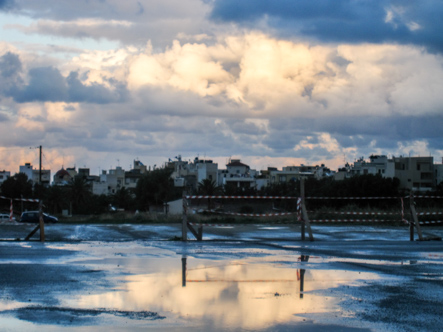
I fail to meet up the Canadian girl I had earlier met in Kalambaka, after setting a date to meet, "10am by the lion fountain." But after heading West to Reythmnon, and then on to Hania, I am standing around eating an apple when she walks by with another American guy, setting up a real estate business in Crete. We join forces for the day, and dodge roadblocks of burning trees and the tractors of angry farmers by night. I veer West, out to Agios Nikolaos and Sitia, and on the last day in Heraklion run into the duo once again (once again, eating an apple), and join them for a quick cafe before heading back to Athens on what will hopefully be the last ferry of this trip.

Bus rides interrupted in the middle of the night: farmers blockade highways in protest of the austerity measures. Greece, 2009. Everyone has to pile out, walk through the tractors, and get on a new bus on the other side.

Fitting, I think, the end of Greece and the end of Europe. Onwards, to a much greater unknown: the Middle East.
